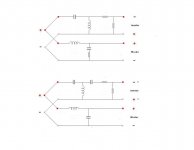Hi there
Im after some advice on 2 way crossovers. this is my first build so please keep explanations simple!
I am using:
tweeter:
response ribbon tweeter
nominal impedance 6 ohm
sensitivity 92db
it is recommended to be crossed over at 2500hz
Woofer:
response 6" kevlar woofer
nominal impedance 8ohm
sensitivity 85db
if you need more information i can scan the info sheets for frequency response charts and impedance charts etc
i was thinking i would do a first order crossover due to simplicity but i dont quite understand how much higher than the recommended crossover frequency i would have to go .Its lowest range is 1.8khz and i dont want to damage them by putting low frequency through them. The woofer appears to have rather varied response after 2 to 3khz as well.
also i dont quite know what i would have to do to balance up the sensitivity of the speakers. i was thinking an l-pad would do the trick but if anyone has better suggestions i would like to hear.
Im after some advice on 2 way crossovers. this is my first build so please keep explanations simple!
I am using:
tweeter:
response ribbon tweeter
nominal impedance 6 ohm
sensitivity 92db
it is recommended to be crossed over at 2500hz
Woofer:
response 6" kevlar woofer
nominal impedance 8ohm
sensitivity 85db
if you need more information i can scan the info sheets for frequency response charts and impedance charts etc
i was thinking i would do a first order crossover due to simplicity but i dont quite understand how much higher than the recommended crossover frequency i would have to go .Its lowest range is 1.8khz and i dont want to damage them by putting low frequency through them. The woofer appears to have rather varied response after 2 to 3khz as well.
also i dont quite know what i would have to do to balance up the sensitivity of the speakers. i was thinking an l-pad would do the trick but if anyone has better suggestions i would like to hear.
Here there are some tools to play Strassacker: Lautsprecher - Boxen - Selbstbau
Woofer is sensible ,also ,some parameters may vary in different size and geometry of the cabinet .
As you can check from that site ,any capacitor (MKT or MKP types ) from 1 to 10 uF will protect your tweeter ...at low volume .
Woofer is sensible ,also ,some parameters may vary in different size and geometry of the cabinet .
As you can check from that site ,any capacitor (MKT or MKP types ) from 1 to 10 uF will protect your tweeter ...at low volume .
the 2nd order crossovers have a steeper cutoff for frequency response as i understand it, but what is the difference between the types?
Butterworth
Linkwitz Riley
Bessel
which one is best for my application and why?
and as i understand it these put the tweeter out of phase so you have to swwitch the positive and negative dont they?
Butterworth
Linkwitz Riley
Bessel
which one is best for my application and why?
and as i understand it these put the tweeter out of phase so you have to swwitch the positive and negative dont they?
the 2nd order crossovers have a steeper cutoff for frequency response as i understand it, but what is the difference between the types?
Butterworth
Linkwitz Riley
Bessel
which one is best for my application and why?
and as i understand it these put the tweeter out of phase so you have to swwitch the positive and negative dont they?
With a real world crossover, sometimes you just take the slopes you can get. Working with a drivers natural response, you add filters to shape the response. With luck, you can get the drivers close to being in phase at the x-over point so that they add to make a flat response. In general, steep slopes allow for greater power handling for the tweeter, and can help with breakup issues of the woofer.
The tweeter can be padded using two resistors. In this case, probably two 5 ohm resistors would get you in the ballpark.
2nd order Linkwitz Riley is the best to use if your knowlege is minimal, this will give the flattest response and reasonable tweeter protection. You will need an L pad for the tweeter. L pad calculator - attenuation dB damping impedance decibel loudspeaker speaker - sengpielaudio Sengpiel Berlin
more info on xovers: Passive Crossover Network Design
You may also need to consider baffle step compensation: http://www.quarter-wave.com/General/BSC_Sizing.pdf
more info on xovers: Passive Crossover Network Design
You may also need to consider baffle step compensation: http://www.quarter-wave.com/General/BSC_Sizing.pdf
With a real world crossover, sometimes you just take the slopes you can get.
thats one way of looking at it 😛
Attachments
- Status
- Not open for further replies.
- Home
- Loudspeakers
- Multi-Way
- Crossover advice please

